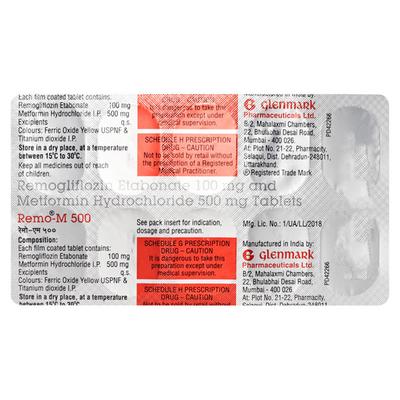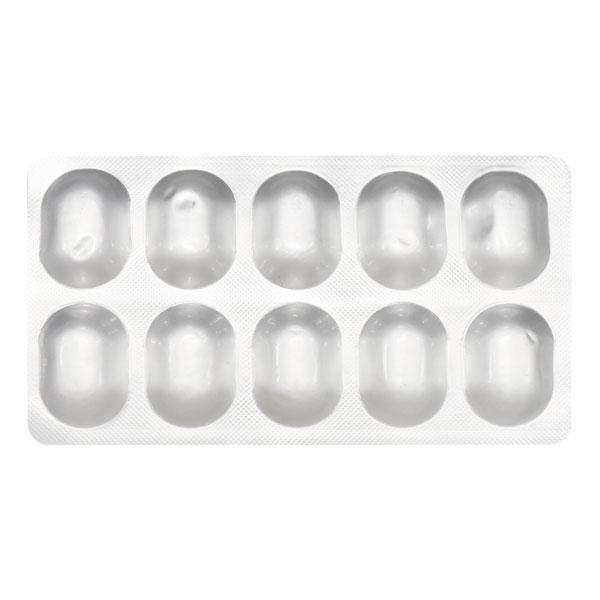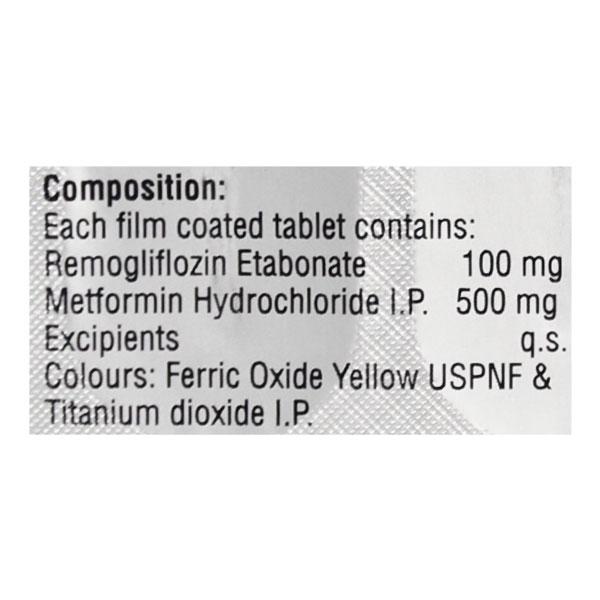

Netmeds First Membership
Quick Links
Introduction About REMO M 500MG TABLET
REMO M 500MG TABLET is a combination of Metformin and Remogliflozin which belongs to the group of medicines called Antidiabetic agents. It is used to improve glycaemic control among patients with Type II diabetes mellitus when diet, exercise and other conventional managements does not provide adequate control on blood glucose levels. Take REMO M 500MG TABLET strictly as instructed by your doctor. Do not stop using this medicine abruptly without consulting your doctor.
While taking REMO M 500MG TABLET, always carry a sugary snack with you and consume it immediately when experience any signs of hypoglycemia (such as tiredness, fatigue, hunger, irritability, lack of concentration). Before taking REMO M 500MG TABLET inform your doctor if you have any liver, kidney or heart problems. You must also inform your doctor if you have low blood pressure, breathing problems, type I diabetes, urinary tract infections or scheduled for an X-ray as a precaution. During therapy with REMO M 500MG TABLET, your doctor might regularly monitor your blood sugar levels and kidney functions to avoid the risk of unwanted side effects. He/she might also ask you to make certain lifestyle changes such as following a healthy diet, regular physical exercise and quitting alcohol consumption to achieve better results.
Follow proper foot care and regularly check your foot for any exacerbations or ulcers. REMO M 500MG TABLET is not recommended for use in patients with severe uncontrollable diabetes. It is also not suitable for use in patients with alcoholism and severe systemic infections. The most common side effects of taking [GBKEYWORD] are low blood sugar levels, nausea, flatulence, constipation, stomach pain, dizziness, changes in taste, a sore and red tongue, urinary tract infection, fever, low blood pressure, passing no urine or more urine, thirst, increased urination at night, anemia, weight loss and joint pain. However, if these side effect bothers you or worsens contact your doctor.
Uses Of REMO M 500MG TABLET
- Improves glycaemic control among patients with Type II diabetes mellitus
How REMO M 500MG TABLET Works
REMO M 500MG TABLET is an antidiabetic medicine. It contains two medicines namely metformin, and remogliflozin. Metformin makes the body more sensitive to insulin (a hormone involved in glucose metabolism). This helps our body cells to utilize more circulating blood glucose. Additionally, it can stop glucose production in the liver and reduces its absorption in the body. Remogliflozin is a SGLT2 inhibitor. It works on your kidneys and eliminates excess blood sugars via urine. It also reduces strain on your heart and kidneys and boosts blood circulation across your body.
How to use REMO M 500MG TABLET
Take REMO M 500MG TABLET as advised by your physician. Swallow the medicine with a glass of water. Do not crush or chew the medicine. REMO M 500MG TABLET should be taken preferably with meals to avoid nausea or stomach upset. Your doctor will decide the correct dose and duration of therapy for you depending upon your age, body weight and disease condition. Continue to take REMO M 500MG TABLET for the stipulated duration instructed by your doctor without any interruption to achieve better results.
Side Effects Of REMO M 500MG TABLET
Common
- Hypoglycemia (low blood sugar)
- Nausea, vomiting
- Flatulence, diarrhea, constipation, stomach pain, loss of appetite
- Headache, dizziness
- Changes in taste
- Vitamin B12 deficiency (signs include extreme tiredness, a sore and red tongue, pins and needles)
- Urinary tract infection, fever
- Passing little or no water
- Cough
- Abnormal level of blood lipids
- Weakness
- Viral upper respiratory tract infection
- Low blood pressure that makes you feel dizzy while standing up or changing position (orthostatic hypotension)
Uncommon
- Anaemia
- Vertigo (spinning sensation)
- Eye pain, increased flow of tears
- Oral sores, gut inflammation, acid reflux, heartburn
- Weight loss
- Dehydration, thirst
- Joint pain, back pain, musculoskeletal pain
- Anxiety, Lack of sleep
- Increased urination, painful or difficult urination, frequent urination at night
- Inflammation of genital areas (penis or vagina)
Stop taking REMO M 500MG TABLET and contact your doctor immediately if you experience any of the following side effects:
- Serious allergic reaction (such as hives, swelling of the face, lips, tongue or throat causing difficulty in breathing or swallowing)
- Signs of liver problems (such as nausea or vomiting, stomach pain, unusual or unexplained tiredness, loss of appetite, dark urine, yellowing of the skin or the whites of the eyes)
- Signs of lactic acidosis (cold hands or feet, dizziness or light-headedness, slow or irregular heartbeat, weakness or tiredness, unusual muscle pain, trouble breathing, sleepiness or drowsiness, stomach pains, nausea or vomiting)
- Signs of severe urinary tract infections such as fever, chills, burning sensation when passing urine, pain in back or sides, and/or blood in urine
- Signs of Fournier’s Gangrene such as fever, pain and swelling in the genitals or anal area, unpleasant odour coming from the affected skin tissue, crackling sound when touching the affected area, and/or dehydration
- Signs of dehydration such as very dry, sticky mouth, feeling very thirsty, passing little or no urine, feeling very sleepy or tired, and/or fast heartbeat
- Signs of diabetic ketoacidosis such as nausea, vomiting, stomach pain, excessive thirst, fast and deep breathing, confusion, unusual sleepiness or tiredness, fruity smelling breath, a sweet or metallic taste in mouth, a different odour in urine or sweat, rapid weight loss
How To Manage Side Effects
Constipation
Increasing fiber intake by including more fruits, vegetables, and whole grains in your diet can help soften stools and promote regular bowel movements. Ensure you stay hydrated by drinking plenty of water throughout the day, as dehydration can contribute to constipation. Regular physical activity also plays a crucial role in maintaining healthy bowel function. Exercise helps stimulate the muscles in your intestines, promoting smoother digestion. Establishing a consistent bathroom routine, such as attempting to have a bowel movement at the same time each day, can also train your body to regulate bowel movements. In some cases, over-the-counter laxatives or stool softeners may be recommended, but it's important to use them under the guidance of a healthcare professional and not as a long-term solution. If constipation persists or is accompanied by other concerning symptoms, it's advisable to consult with a healthcare provider to rule out any underlying medical conditions.
Dizziness Or Drowsiness
Managing dizziness involves addressing potential underlying causes and making lifestyle adjustments. If you experience sudden or severe dizziness, it's important to sit or lie down to manage the risk of falling. Ensure proper hydration and maintain a balanced diet to regulate blood sugar levels. Avoid sudden movements and try to rise slowly from a seated or lying position. If dizziness persists, it's advisable to consult with a healthcare professional to rule out any serious medical conditions.
Headache
Adequate hydration is crucial, as dehydration can contribute to headaches. Ensure you are getting enough sleep and maintaining a consistent sleep schedule. Relaxation techniques, such as deep breathing or meditation, can help alleviate tension that may be contributing to the headache. If headaches persist, worsen, or are accompanied by other concerning symptoms, it's advisable to consult with a healthcare professional to identify any underlying causes and determine an appropriate course of action.
Hypoglycemia
Managing hypoglycemia involves maintaining stable blood sugar levels through dietary and lifestyle choices. Eat regular, balanced meals containing a mix of carbohydrates, protein, and healthy fats. Choose complex carbohydrates with a low glycemic index to avoid rapid glucose fluctuations. Practice portion control and include protein and fiber in your meals to slow down glucose absorption. Monitor blood sugar levels regularly, stay physically active, and be cautious with medications, adjusting them as needed under healthcare supervision. Carry a fast-acting glucose source for emergencies and seek medical attention if experiencing severe or persistent hypoglycemia. Always consult with a healthcare professional for personalized guidance.
Warning & Precautions
Pregnancy
Monitoring requiredREMO M 500MG TABLET should be used in pregnant women only if considered necessary by the physician. Your doctor will prescribe REMO M 500MG TABLET only if the therapeutic benefits overweigh the risk to the foetus. Therefore, inform your doctor before taking it.
Breastfeeding
ContraindicatedREMO M 500MG TABLET is not recommended for use in breastfeeding women. However, consult your doctor before taking it.
Driving and Using Machines
Use with CautionDo not drive or operate machines if you experience shaking, sweating, change in vision and/or feel dizzy after taking REMO M 500MG TABLET.
Alcohol
Consult your doctorAvoid consumption of alcohol while taking REMO M 500MG TABLET since it may increase risk of diabetic ketoacidosis.
Kidney
ContraindicatedREMO M 500MG TABLET is not recommended for use in patients suffering from kidney problems such as moderate to severe renal impairment. Consult your doctor before taking the medicine. Therefore, consult your doctor for advice.
Liver
Consult your doctorREMO M 500MG TABLET is not recommended for use in patients with moderate to severe liver impairment. It should be used with caution in patients with other liver problems. Therefore, consult your doctor for advice.
Allergy
ContraindicatedDo not take REMO M 500MG TABLET if you are allergic Metformin and Remogliflozin and/or any other ingredients of this medicine.
Lungs
ContraindicatedREMO M 500MG TABLET is not recommended for use in patients with severe infection of lungs or respiratory tract. Therefore, consult your doctor before taking it.
Heart Disease
ContraindicatedREMO M 500MG TABLET is not recommended for use in patients with heart problems (such as acute heart failure or a recent heart attack). Therefore, consult your doctor before taking it.
Use In Pediatrics
ContraindicatedREMO M 500MG TABLET is generally not recommended for use in children and adolescents (aged below 18 years). Therefore, consult your doctor for advice.
Use In Geriatrics
ContraindicatedREMO M 500MG TABLET is not recommended for use in elderly patients (aged 75 years/above). Therefore, consult your doctor for advice.
Others
REMO M 500MG TABLET is not recommended for use if you:
- Have severe, uncontrollable diabetes
- Have lactic acidosis or ketoacidosis (buildup of lactic acid or ketones in the body)
- Are dehydrated (due to severe vomiting or diarrhea during recent days)
- Have any systemic infection which is severe
- Have shock or problems in blood circulation
- Have problems in breathing
- Are an alcoholic
Before taking REMO M 500MG TABLET, inform your doctor if you:
- Are about to have any X-ray or scan
- Are about a have a major surgery
- Are in fasting
- Have type 1 diabetes
- Have low blood pressure
- Have urinary tract infections
Interactions
A. Drug-Drug interactions:
Before taking REMO M 500MG TABLET, inform your doctor if you are taking any of the following medicines such as:
- Other antidiabetic agents (Ex. glimepiride, glyburide, gliclazide, rosiglitazone)
- Iodine contrast medium (used during X-rays)
- Beta-2 agonists (Ex. salbutamol or terbutaline)
- Corticosteroids (used to manage pain and inflammation) Ex. hydrocortisone, prednisolone
- Diuretics (water pills) Ex. furosemide, hydrochlorothiazide
- Medicines used to manage pain and inflammation (such as ibuprofen and celecoxib)
- Heart medicines (such as atenolol, propranolol, captopril, enalapril, ramipril, lisinopril, losartan, valsartan, olmesartan, telmisartan, verapamil, quinidine, procainamide, amiodarone, sotalol)
- Cimetidine (a medicine used in the management of stomach ulcers)
- Dolutegravir (an antiviral agent)
- Rifampicin (an anti-TB medicine)
- Ranolazine (a medicine used for chest pain)
- Trimethoprim (a medicine used to manage bacterial infection)
- Anticancer medicines (Ex. vandetanib, crizotinib and Olaparib)
- Isavuconazole (an antifungal agent)
- Salicylic acid (a medicine used to manage skin problems like acne)
- Antidepressants (Ex. phenelzine, selegiline)
- Adrenaline (a medicine used to manage shock caused by allergic reactions or collapse)
- Thyroid hormones Ex. levothyroxine, liothyronine
- Oral contraceptives
Overdosage:
If you or anyone else accidentally take more REMO M 500MG TABLET, consult your doctor immediately or visit the nearby hospital. Symptoms of overdose are Nausea, vomiting, stomach pain with muscle cramps, feeling generally unwell with severe tiredness, difficulty in breathing, dizziness, diarrhoea, and/or flatulence.
Synopsis
| Drug | : | Metformin, Remogliflozin |
| Pharmacological Category | : | Biguanides, SGLT2 Inhibitors |
| Therapeutic Indication | : | Improve glycemic control in among diabetic patients |
| Dosage Forms | : | Tablet |
More Information
Storage
- Keep REMO M 500MG TABLET out of reach of children
- Store REMO M 500MG TABLET at room temperature
FAQs About REMO M 500MG TABLET
Q: What is REMO M 500MG TABLET used for?
A: REMO M 500MG TABLET is used to improve glycaemic control among patients with Type II diabetes mellitus when diet, exercise and other conventional managements does not provide adequate control on blood glucose levels.
Q: How long should I take REMO M 500MG TABLET?
A: You need to take REMO M 500MG TABLET as long as your doctor or physician prescribes you the medicine. Your doctor will decide the correct dose and duration of therapy for you depending upon your age, body weight and disease condition.
Q: What to do if I forgot to take a dose of REMO M 500MG TABLET?
A: If you forgot to take a dose of REMO M 500MG TABLET, take it as soon as you remember. However, if it is time for the next dose of REMO M 500MG TABLET, skip the missed dose and take the next one regularly. Do not take a double dose of REMO M 500MG TABLET to compensate the missed ones.
Q: What are the most common side effects of taking REMO M 500MG TABLET?
A: The most common side effects of taking [GBKEYWORD] are low blood sugar levels, nausea, flatulence, constipation, stomach pain, dizziness, changes in taste, a sore and red tongue, urinary tract infection, fever, low blood pressure, passing no urine or more urine, thirst, increased urination at night, anemia, weight loss and joint pain. However, if these side effect bothers you or worsens contact your doctor.
Q: Can I stop taking REMO M 500MG TABLET without consulting your doctor?
A: No. You should not stop taking REMO M 500MG TABLET without consulting your doctor because it may lead to reversal of symptoms. If you feel better after using REMO M 500MG TABLET, consult your doctor for advice.
Q: Will taking a higher dose of REMO M 500MG TABLET be more effective?
A: No, taking a higher dose of REMO M 500MG TABLET will not be effective rather it can lead to toxicity. Always take the dose prescribed by your doctor. If the prescribed dose is not effective for you, consult your doctor for advice. Your doctor might increase the dose or suggest an alternative therapy.
Q: Can REMO M 500MG TABLET cause constipation?
A: Yes, REMO M 500MG TABLET may cause constipation in some individuals. Eat plenty of fiber rich foods such as fresh fruits, vegetables, and cereals and drink plenty of water. Exercise more regularly. Ask for your doctor’s advice if constipation does not improve.
References
1. KD. Tripathi. Insulin, Oral Hypoglycaemic Drugs and Glucagon. Essentials of medical pharmacology. Seventh edition. 2013. Page-275.
2. Wiley. Remogliflozin. Metabolic Syndrome: Underlying Mechanisms and Drug Therapies. 2011. Page-371.
3. Calette Corcoran; Tibb F. Jacobs. Metformin. StatPearls [Internet]. NIH. National Library of Medicine. National center for biotechnology information. PMC. PubMed Central. [Revised on May 2022] [Accessed on 6th January 2024] https://www.ncbi.nlm.nih.gov/books/NBK518983/#article-25065.s3
4. Nasser Mikhail. Remogliflozin etabonate: a novel SGLT2 inhibitor for treatment of diabetes mellitus. NIH National Library of Medicine, National center for biotechnology information. Pubmed.gov. August 2015. [Accessed on 6th January 2024] https://pubmed.ncbi.nlm.nih.gov/26288025/
5. Metformin Hydrochloride. Rx Farma Limited. Electronic Medicines Compendium (EMC). [Revised in July 2022] [Accessed on 6th January 2024] https://www.medicines.org.uk/emc/files/pil.11951.pdf
6. Brown & Burk UK Ltd. Metformin 500 mg and 850 mg film-coated Tablets. Electronic Medicines Compendium (EMC). [Revised in May 2022] [Accessed on 6th January 2024] https://www.medicines.org.uk/emc/files/pil.10759.pdf
7. Torrent Pharmaceuticals Ltd. Zucator 100. [Revised in July 2020]. [Accessed 6th January 2024] https://www.torrentian.com/pisheet/Upload/PI_Sheet/2859.pdf
Useful Diagnostic Tests
- Blood Glucose Fasting (FBS)
- Random Blood Sugar (RBS)
- Post Prandial Blood Sugar (PPBS)
- Insulin-Fasting










